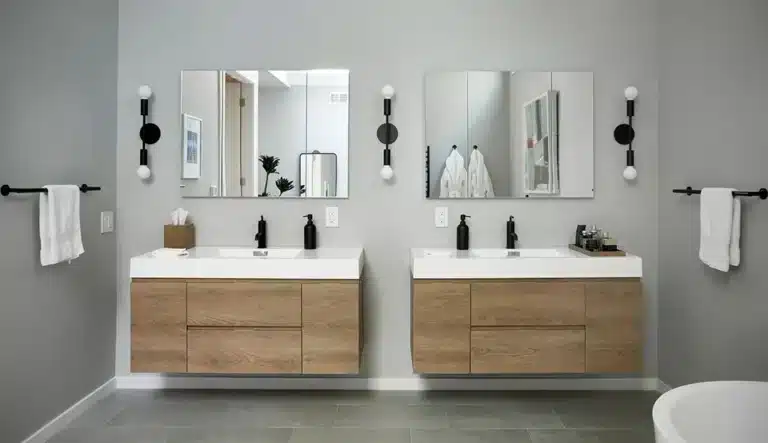If you’re anything like me, I know that renovation is exciting… but also a little overwhelming. Especially when it comes to picking the right paint. You walk into the store ready to grab a can or two, and suddenly you’re faced with 30 different finishes, 200 shades of white, and questions like, “Wait, what even is satin paint? Do I need that? Or is semi-gloss better?” And if you’re standing there thinking about your bathroom? Oh boy. That adds a whole new layer of stress. Bathrooms deal with steam, moisture, splashes, and sudden temperature changes. So, grabbing just any paint off the shelf won’t cut it. But don’t worry; I’m here to walk you through it. In this article, we’re going to talk about what kind of paint actually works best for bathroom walls. Satin? Semi-gloss? Or maybe something else entirely?
Let’s break it all down in a simple, no-fuss way, because choosing bathroom paint shouldn’t give you a headache. Ready? Let’s go.
Why Bathroom Paint Needs to Be Different?
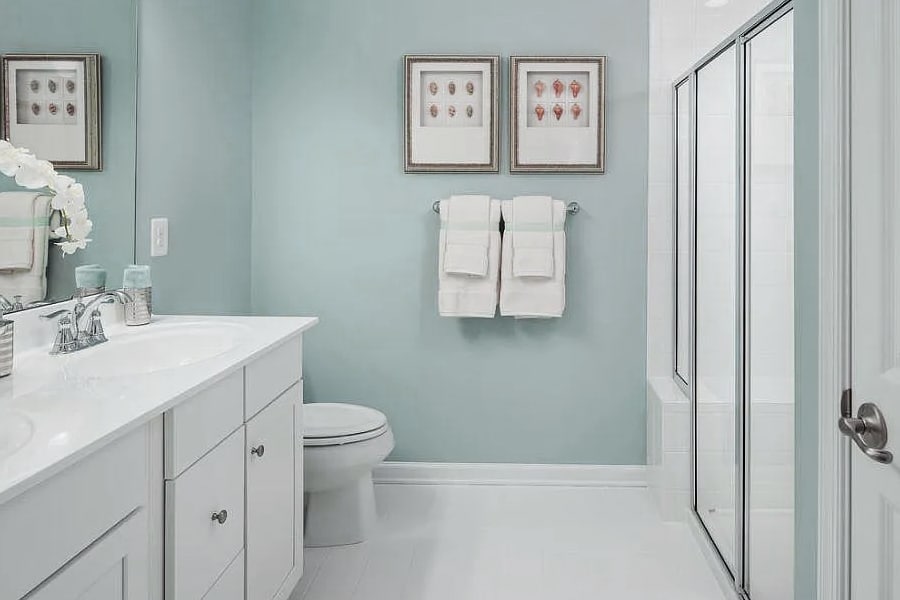
Credit: metrobathandtile.com
So, we know that bathrooms aren’t like other rooms in your home. They deal with a lot more moisture, steam, and sudden temperature changes. Every time someone takes a hot shower, the air fills with humidity. Over time, that moisture can sneak into your bathroom walls and ceilings, especially if you don’t have great ventilation.
This kind of damp environment can cause:
- Peeling paint
- Mildew or mold
- Stains and bubbling
- Worn-out paint finishes
That’s why choosing the right type of paint for bathroom walls is so important, not just for looks, but also for moisture resistance, durability, and long-term upkeep. Whether you’re updating a full bath or wondering what kind of paint for a bathroom powder room works best, the finish you choose really matters.
And if you’re already dealing with peeling or damaged paint, don’t worry; you’re not alone. Here’s a helpful guide on how to fix peeling paint in your bathroom before you repaint, so you can start fresh with the right foundation.
Let’s Talk About Paint Finishes
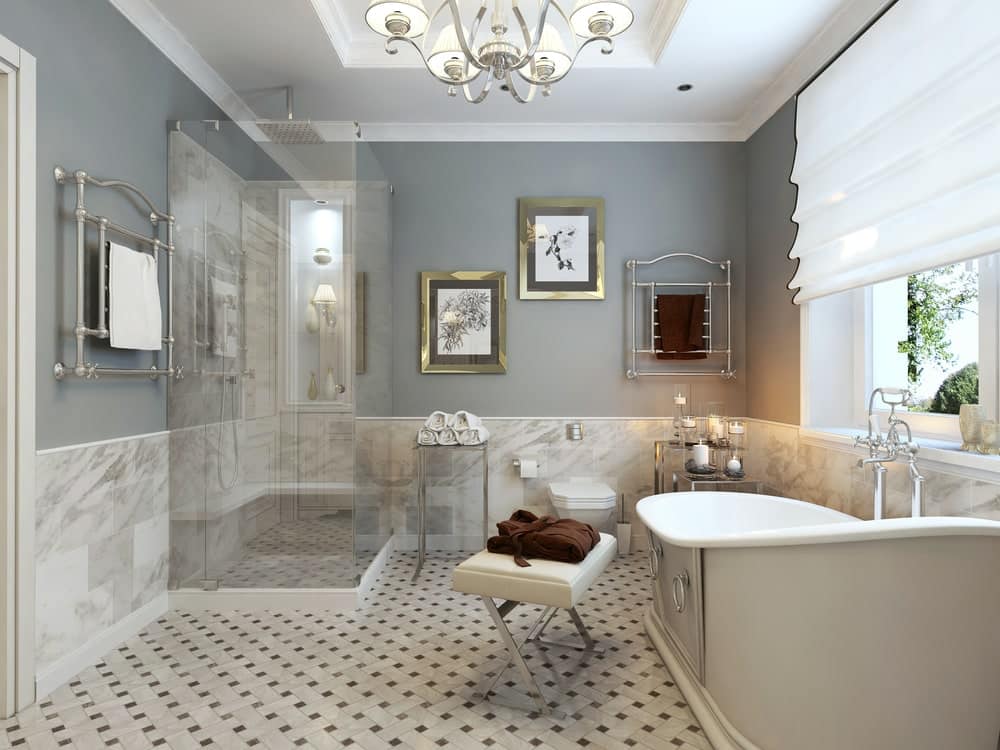
Credit: esppainting.com
Before we jump into which is the best paint finish for a bathroom, let’s take a minute to talk about what paint sheen actually means.
Paint finishes (also called sheens) range from completely flat to super glossy. This describes how much the paint will reflect light once it’s dry. It also gives you a good idea of how easy to clean and how durable it will be, two key things to consider when choosing paint for a bathroom.
Here are the most common sheens, from least shiny to most shiny:
- Flat or Matte Paint: No shine at all. This kind of base paint is great for hiding flaws, but it isn’t known for being moisture-resistant or washable. Not the best pick for bathroom walls.
- Eggshell Paints: These have a soft, barely-there glow. While they’re more durable than matte paint, eggshell finishes still aren’t ideal for steamy or humid environments.
- Satin Paint Finish: A popular middle-ground option. Satin paint in a bathroom offers some sheen, holds up well against moisture, and is fairly easy to clean. It’s often recommended as the best sheen for bathroom walls in powder rooms or bathrooms with good airflow.
- Semi-Gloss Finish: If you’re looking for extra protection, semi-gloss for bathroom walls is a smart move. It’s shiny, strong, and great at resisting moisture. Plus, semi-gloss paints are perfect for areas that need frequent cleaning.
- Gloss or High-Gloss Paint: This is the shiniest option out there. Gloss finishes in bathrooms are durable and water-resistant, making them great for cabinets and trim. Just keep in mind, they tend to show every little imperfection.
So when you’re standing there wondering what kind of paint for bathroom renovations makes the most sense, think about more than just paint colors. The sheen, finish, and overall performance matter just as much, if not more.
What Kind of Paint Is Best for Bathroom Walls?
✅ Best Overall: Satin or Semi-Gloss
Most painters and experts agree, satin and semi-gloss are your best bets for bathroom walls. But let’s take a closer look at all your options.
Why Satin?
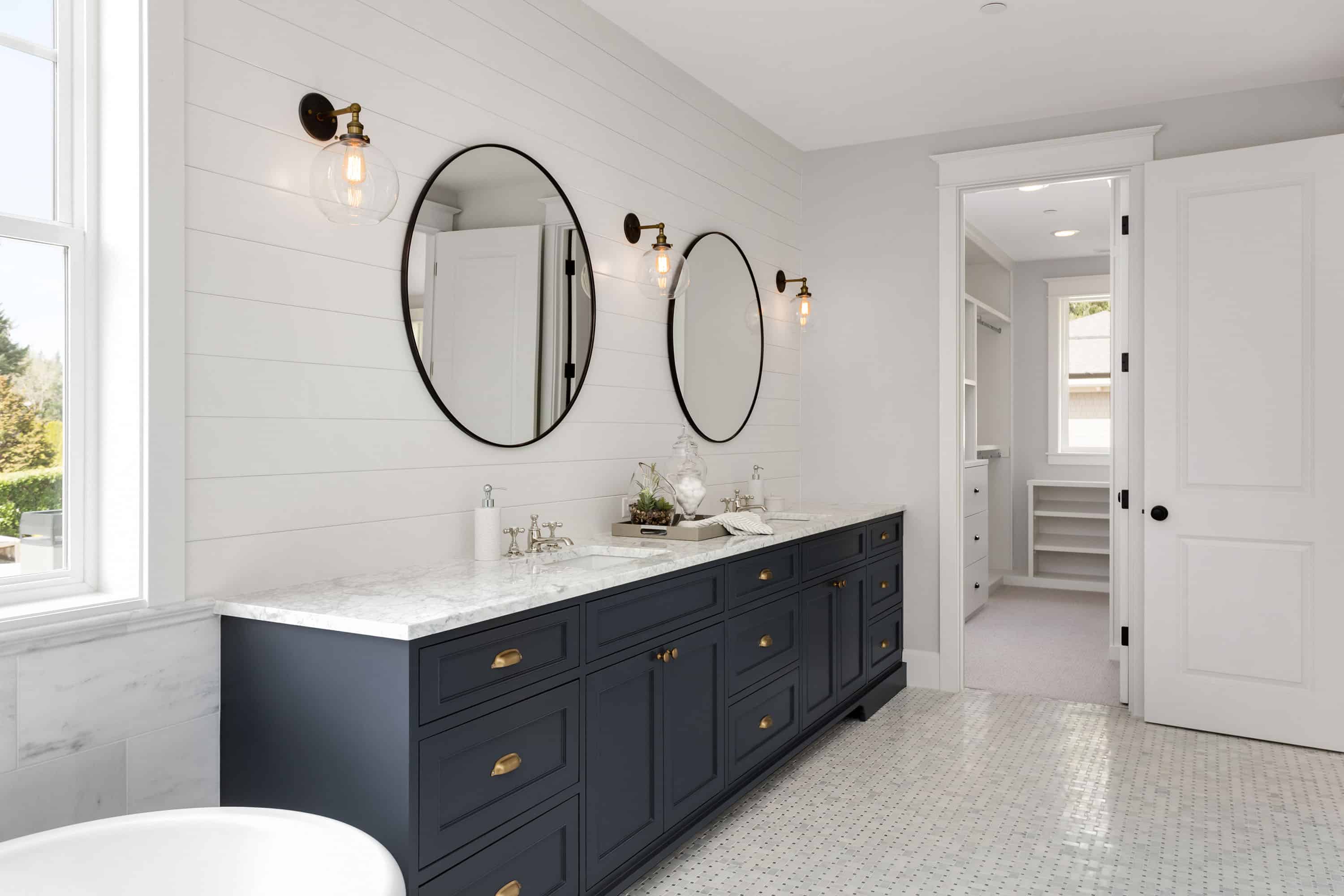
Credit: realhomes.com
Satin paint is a great middle-ground paint finish for bathrooms. It has a soft, subtle glow without being overly shiny. It’s also moisture-resistant, making it a solid option for spaces that have good ventilation.
Pros
- Easy to clean
- Hides small imperfections
- Looks soft and modern
Cons
- May still struggle in very humid bathrooms
- Not as durable as semi-gloss
Use satin paint in:
- Powder rooms (no shower or tub)
- Bathrooms with strong ventilation (like a fan or a window)
This is often considered the best sheen for bathroom walls when you’re going for a stylish but practical look.
Why Semi-Gloss?
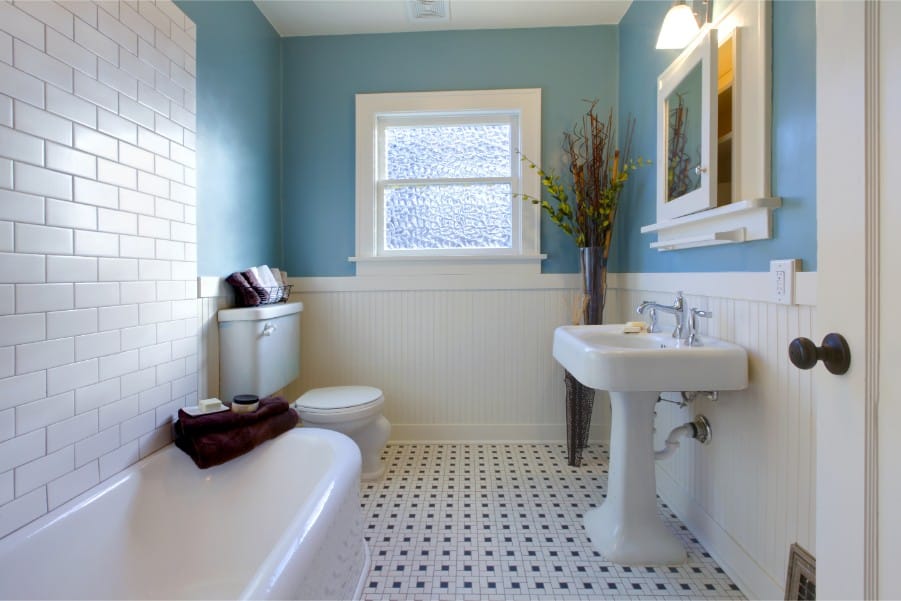
Credit: paintzen.com
Semi-gloss paint has more shine than satin and stands up better against moisture. It’s super easy to clean, and it resists mildew, making it ideal for busy bathrooms with frequent use.
Pros
- Very durable
- Resists moisture and mildew
- Great for high-traffic bathrooms
Cons
- Can highlight bumps and flaws on the wall
- Slightly shinier than some people prefer
Use semi-gloss paint in:
- Full bathrooms with showers or tubs
- Kids’ bathrooms
- Smaller bathrooms with poor ventilation
If you’re looking for semi-gloss for bathroom walls that need frequent wiping or scrubbing, this is a safe and smart choice.
Flat or Matte Paint – Not Ideal for Bathrooms
You might have heard about flat paints. Also called matte paint, it has no shine at all. It’s great at hiding imperfections and gives a soft, elegant look, but it doesn’t handle moisture well. In bathrooms, it can absorb steam and lead to peeling, bubbling, or even mildew growth.
Pros
- Hides surface flaws
- Smooth, non-reflective finish
Cons
- Poor moisture resistance
- Difficult to clean
- Not suitable for humid areas
Avoid using flat/matte paint in:
- Any bathroom with a shower or bath
- Rooms with poor ventilation
If you’re updating a powder room without a shower, flat matte base paints can still be an option; just be cautious.
Eggshell Finish – A Soft Look, But Still Risky
Eggshell paints offer a soft, low-luster finish; just a step above flat. They look great in living rooms or bedrooms, but they’re not made for steamy bathrooms. While a bit more durable than matte, they still struggle in high-humidity spaces.
Pros
- Soft, subtle sheen
- Hides small flaws better than glossier paints
Cons
- Limited durability in wet areas
- Harder to clean than satin or semi-gloss
Use eggshell in
- Half-baths or powder rooms with great ventilation
- Dry, low-use spaces
Looking for a little shine but don’t love satin? Eggshell might be tempting, but it’s not the best type of paint for bathroom walls where water and steam are regular guests.
What About Ceilings?
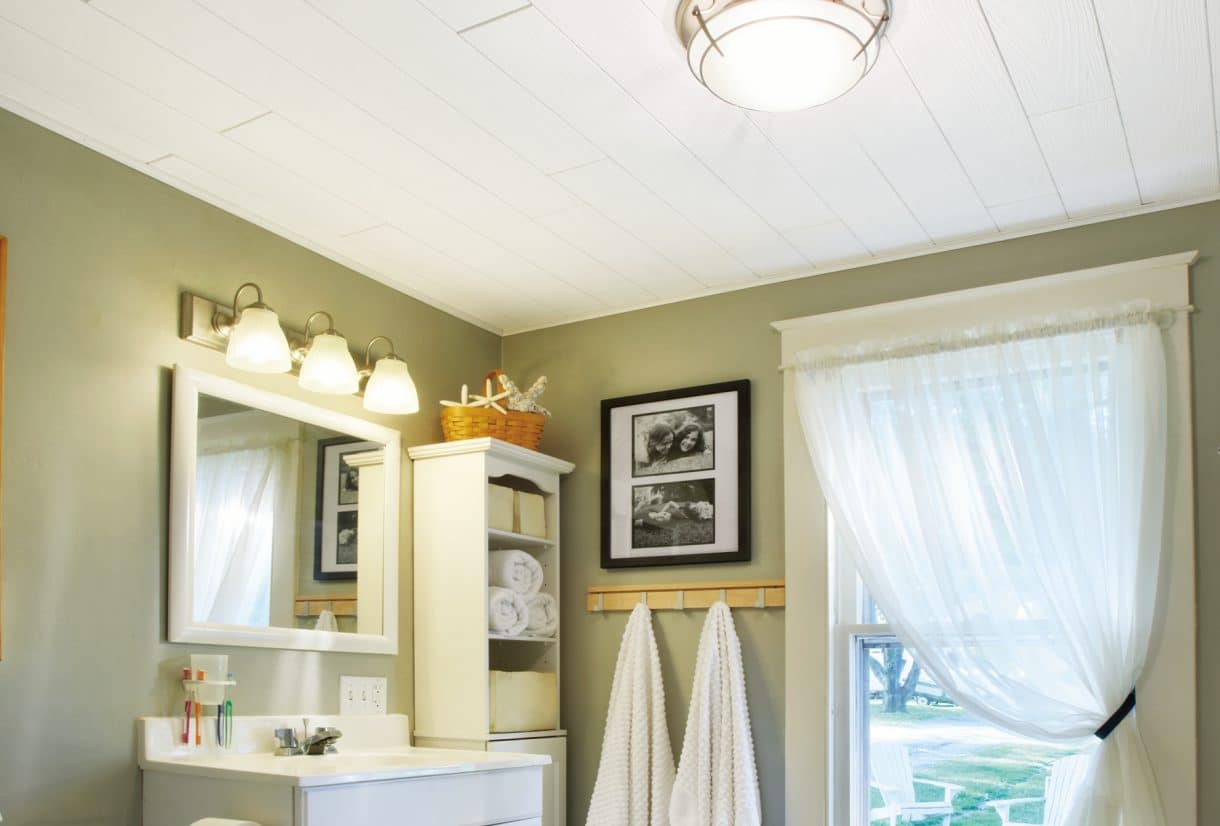
Credit: armstrongceilings.com
Here’s a detail many people overlook: bathroom ceilings matter too. Steam rises, so the ceiling often takes the brunt of that hot, moist air, sometimes even more than the bathroom walls themselves.
If you paint your ceiling with standard flat paint or matte paint, it might soak up moisture and start peeling or growing mildew over time. Not exactly the kind of makeover you’re going for, right?
Flat matte paint with mildew-resistant additives
OR
A satin finish for extra moisture resistance
- In powder rooms (where there’s no shower), a simple flat ceiling paint may be just fine.
- But in a full bathroom, go with satin paint for bathroom ceilings or choose a base paint labeled specifically as “mildew-resistant” or “bathroom-safe.”
Choosing the right paint finish for your ceiling helps prevent bubbling, cracking, and mold down the line.
What Kind of Paint for Bathroom Trim?
Trim, baseboards, and doors need tougher paint than walls. They take more abuse—think of towel racks banging into them, water splashes, and just daily wear and tear.
✅ Best Pick: Semi-Gloss or Gloss Paint
These gloss finishes for bathroom trim are:
- Hard and durable
- Moisture-resistant
- Easy to clean
That’s why semi-gloss paints or even high-gloss paint are perfect for areas like:
- Door frames
- Baseboards
- Window trim
- Vanity surrounds
Pro tip: If you’re painting bathroom cabinets too, semi-gloss for bathroom vanities or gloss paint will give them a sleek finish that’s easy to clean and stands up to water splashes.
What About Special Bathroom Paint?
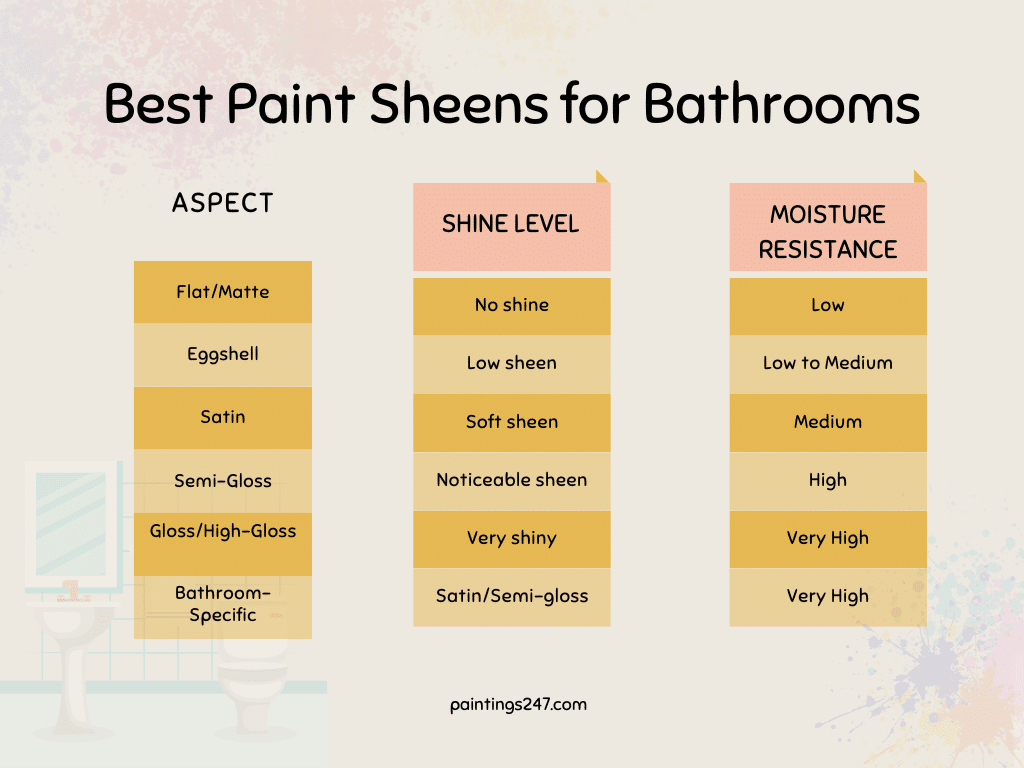
Wondering what kind of paint for bathroom use goes the extra mile? There’s a category just for that.
Many paint brands now sell bathroom-specific paints. These come with mildew-resistant additives, higher moisture resistance, and often fall under satin or semi-gloss finishes.
You might see them labeled as:
- “Kitchen & Bath”
- “Moisture-resistant paint”
- “Mildew-resistant finish”
Yes, they cost a bit more than your standard paint colors, but they’re well worth it, especially in:
- Bathrooms without ventilation fans
- Older homes with humidity issues
- Small bathrooms where steam lingers
This is a great option if you’re still unsure what paint finish for bathroom powder rooms or high-use areas is safest.
And while you’re upgrading your bathroom walls, don’t forget the ceiling; it’s just as exposed to moisture. Check out this guide on discovering the best ceiling paint for bathrooms and beyond to find the right finish and brand for long-lasting results overhead.
Common Mistakes to Avoid
Let’s save you some trouble by avoiding the most common paint mistakes people make in bathrooms:
- Using Flat or Matte Paint in a Steamy Bathroom
It may look nice at first, but it won’t last. Moisture will ruin it quickly.
- Skipping Primer
Always use a primer, especially if you’re painting over a darker color or a glossy surface.
- Ignoring Ventilation
Even with the right paint, poor airflow will still cause problems. Consider adding or fixing an exhaust fan.
- Choosing Based on Shine Alone
Just because a finish is shinier doesn’t mean it’s better for your space. Think about traffic, moisture, and your personal style.
Final Coat
So, what kind of paint for a bathroom is really the best?
It depends a bit on your specific bathroom, but in most cases:
- Satin is great for lightly used or well-ventilated bathrooms.
- Semi-gloss is best for high-moisture, high-use spaces.
- Gloss is perfect for trims, doors, and cabinets.
- Special bathroom paints offer extra protection if you want peace of mind.
Take a moment to look around your bathroom. Is there a fan? Do the windows open? Does it feel steamy after showers? These clues will help you make the best decision.
And hey, don’t stress it too much. With the right prep, good paint, and a little time, you’ll have a bathroom that not only looks great but lasts for years.
Happy painting!

